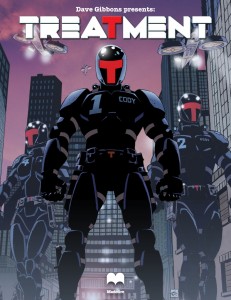I’m guessing there are a lot of comic lovers and writer/artists out there in iPad/iPhone land that have heard about Madefire’s Motion Books App, but for me, and I’m assuming a lot of others too, the first word on the subject was via an announcement made on deviantART, proclaiming a strategic alliance between the two companies. As of now “deviant’s” and visitors to the site have access to the Motion Books web-based content.
For those of you who have not heard about any of this. Motion Books is a new platform that allows artists and writes to create a new breed of comic which can incorporate any mix of animation, sound effects and music in a seamless format. The software might be new, but the idea goes back at least two decades. Artists have long been experimenting with multimedia comic/graphic novel techniques. Marco Patrito’s Sinkha, is a wonderful example of this sort of medium blending, and undoubtedly one of the earliest. Sinkha was first conceived back in the early 90s, and expectedly shows many signs of being an early pioneering effort especially with its clunky interface created with Macromedia Director.
 With Motion Books there is none of this clumsiness. Anyone who has ever experienced the slick digital magazine interfaces, such as that used by ISSUU, will be quite familiar with the way the web-based app feels. Those who have flipped through any number of side-scrolling iPad/Phone apps will have a good idea how it works too. Even for the utterly clueless, the interface is so simple and streamlined that they will be flipping pages in moments.
With Motion Books there is none of this clumsiness. Anyone who has ever experienced the slick digital magazine interfaces, such as that used by ISSUU, will be quite familiar with the way the web-based app feels. Those who have flipped through any number of side-scrolling iPad/Phone apps will have a good idea how it works too. Even for the utterly clueless, the interface is so simple and streamlined that they will be flipping pages in moments.
The current batch of high quality Motion Books are a fantastic example of how comics can make the jump to multimedia but retain a feel that is still solidly rooted in the traditions of the material comics and graphic novels. Just a few pages into my first MB, Dave Gibbsons’ Treatment – Tokyo: Episode 1, I found myself drawn into the atmosphere of the beautiful illustrated neon of a crime ridden future where brutality and revenge has become a televised entertainment phenomenon. The seamless and artful incorporation of animation and sound were integral to the experience. As used here and with the other beautiful first batch of MB there is a distinct feeling that comics are heading to a new level.
The strength of Madefire’s Motion Books platform lays in the tools it gives over to artists free of charge. These tools do a lot to simplify the technical aspects of creating multimedia comics. This circumvents a lot of expensive development time, and empowers content creators to realise their vision with an exciting new medium. Multimedia comics are no gimmick. I believe they are the future, and I hope that Motion Books, along with their Motion Book Tool, will be one the leading vehicle for this evolution. It is not hard to imagine we will see outgrowths on the platform such as “chose your own adventure” works, and game/comic hybrids with interactive puzzles and dialogue choices.

